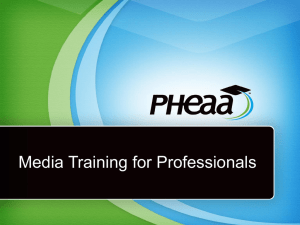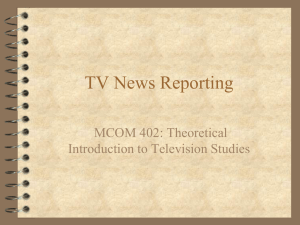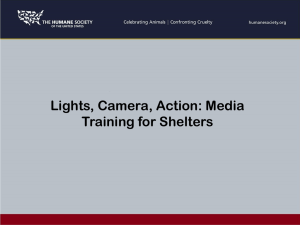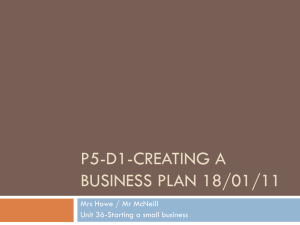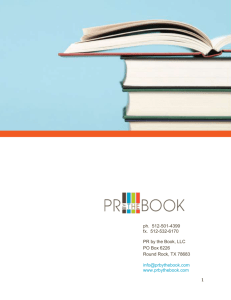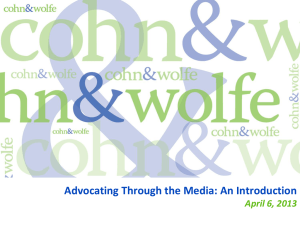Creating an Earned Media event
advertisement
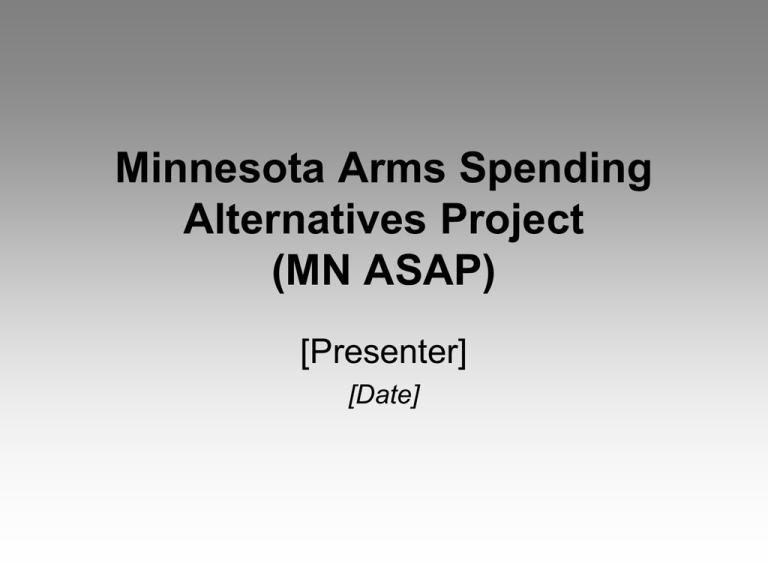
Minnesota Arms Spending Alternatives Project (MN ASAP) [Presenter] [Date] Overview Earned media overview Telling stories Messages Crafting them Getting them across Staying on them What is news The newsroom Working with reporters effectively Building a press list Tools Press releases, pitch letters, radio fees, etc. Opinion pieces Working with broadcast media What to do if a reporter calls you Dealing with unfavorable coverage What is Earned Media and Why Use It? Earned media = Media that doesn’t cost you money, but have to earn (not free) News articles, TV interviews, etc. Contrast with paid media and owned media Earned media can help you: Educate the public Sway elected officials Recruit new members Win your campaigns! The Importance of Telling Stories People love stories Natural way we process information More likely to notice, remember, share information if it is presented as a story To tell a story, use the elements of narrative Protagonist, antagonist, conflict, resolution Emotional impact is key Emotion tells us what’s important in the world How to get emotional impact Help audience identify with “protagonist” (e.g. through personal stories) Appeal to moral values Big-Picture Stories & Messages Big-picture story Broad, all-encompassing story about your effort & why it’s important Message What you’re communicating in a particular interview, etc. Part of your big-picture story Getting Your Message Across Develop concise messages Average quote is 30 words, TV clip is 10 seconds Use the 27/9/3 formula (“sound bites”) Repeat, repeat, repeat! Keep your message consistent Select spokespeople Coordinate between them Discuss big-picture story Develop talking pts & answers to likely questions Train people how to stay on message during an interview Staying on Message During an Interview Don’t allow the reporter to lead you off topic Say “I’d be happy to talk about that, but first I’d like to explain how…” You don’t need to wait for a question to be asked to answer it Never repeat a negative Reinforces it in audience’s mind Instead, neutralize it with a positive statement Staying on Message During an Interview You don’t have to answer every question! Instead, respond using a pivot Pivot = Pivot phrase + talking point Example pivot phrases “The thing is…” “What’s important is…” “What it sounds like you’re really getting at is…” “That’s an interesting question, but first I’d like to address…” Staying on Message During an Interview Pivot examples: Reporter: “Do you really think the MN Congressional delegation will take this seriously?” You: “What it sounds like you’re really getting at is whether military spending is a problem in our country. I think we can all agree that Minnesota cannot afford to spend $8.6 billion dollars funding the wars in Iraq and Afghanistan, when we have a $5 billion budget shortfall here in MN.” Reporter: “What are the chances your group will be successful?” You: “The reality is that Minnesotans are coming together with a unified voice on military spending. We want to bring our tax dollars home for local control.” What is News? Just because it interests you doesn’t mean it’s news News value (“newsworthiness”) 1. Conflict 2. Novelty 3. Timeliness 4. Proximity 5. Prominence 6. Impact 7. Human interest Rank your story in each category, try to increase its rankings What is News? Angle How the story is told, what is emphasized Focus on news value categories with highest rankings Peg Current news item to which you tie your story Makes your story timely Hook Grabs the audience’s attention Encapsulates the story Like a jingle in a commercial How are News Stories Created? Assignment Top-down method Assignment editor => reporter Enterprise Bottom-up method Beat reporter => editor Generally the better stories, & more copy What Reporters Want They want good stories presented in a way that makes their jobs easier Give them that, and you both win Compete hard for space in paper Increasingly harried due to downsizing They want a resource Not your enemy But also not your friend Building Relationships with Reporters Beat reporters at newspapers most important Also consider bloggers, editors, etc. Identify key individuals, do background research Ask to meet at her office or over coffee At the meeting Explain issue & give her background materials Offer yourself as a resource Build the relationship Deliver consistent quality Don’t waste her time Offer exclusives, & suggest other stories on her beat Building Your Press List Press list = List of media contacts likely to be interested in your stories Detailed information & a record of past contacts/stories Be selective Sending materials to those unlikely to be interested is spamming Build your list using internet & phone calls Can use another organization’s list as starting point - but check over everything Keep the list updated Press Releases & Advisories Press release Alerts a reporter to a story Enough to write an article, but also gives contact info Written like a news article Headline, inverted pyramid style, quotes Press advisory Alerts a reporter to an event Answers who, what, where, when, why Formatting & sending See guide for advice Important: Follow with a pitch call! The Pitch Call Purpose: Get a reporter’s attention & convince her to cover your story or event When you call Introduce yourself & your organization If you know the reporter, connect briefly on a personal note Ask if she has a moment to talk Give a brief summary of story or event Ask if she got your release or advisory Be prepared to do an interview on the spot If get answering machine, call back later Radio Feeds & Actualities Audio versions of the press release Used by radio stations in newscasts Lead-in, clip, closing, contact info Feed vs. actuality Feed = Clip prerecorded Actuality = Clip recorded at a live event Make pitch call before sending Not all stations accept these Pitch Letters Used to convince news outlet to interview someone or book them as a guest Format flexible, but keep it short Follow up with a pitch call Press Conferences Staged event where one or more speakers present a story to reporters Opportunity for reporters to ask questions & take photos Difficult for small organizations to use effectively Opinion Pieces in Newspapers Letter to the editor Short letter responding to a current topic Anyone can submit Many people submitting increases chances Can have a few writers & larger number of senders Op-ed Longer opinion piece Most often signed by an expert or public figure Editorial Statement by a paper’s editorial board Meet with editorial board to make your case Radio Interviews Prepare! Learn talking points, practice answers to likely questions Bring documents along to the interview Studio vs. telephone During the interview Treat mic like ear of someone close to you (don’t shout) Speak slowly & clearly Repeat your main messages often Smile! If talk radio, line up people to call in Listen to your interview afterwards & learn from it Television Interviews Prepare! Like radio - but television short-form medium, & visual Pay special attention to: Sound bites Clothing & appearance During the interview Ask that the camera be brought to your eye level Be still (everything looks bigger on camera) Smile! Watch your interview afterwards & learn from it Radio Call-Ins Familiarize yourself with the show Make the call Be prepared to wait Have your points ready & in front of you Tell screener why you’re calling in one short sentence Greet host by name, then immediately make your point Remain calm Can assemble a team of callers for maximum impact Public Service Announcements Short noncommercial messages on TV and radio Used to meet the FCC’s requirement that stations serve “in the public interest” Can use to send a message or announce an event Free airtime, but stiff competition Usually delivered as ready-to-use files, though some stations prefer a script Requirements vary by station Call & ask for individual responsible for PSAs Try to set up a meeting If a Reporter Calls You Most likely to happen in the afternoon or early evening But not always! When get the call, pick up Ask what the story is about If you are willing to talk, say you’re in the middle of something & will call back in 5-10 minutes Compose your thoughts, & then call back If get a voicemail, return the call promptly Remember the reporter is probably working under deadline Dealing with Unfavorable Media Coverage This will happen sooner or later. Don’t panic, and don’t become defensive! If a mistake If small, ignore If moderate, alert the reporter so she doesn’t repeat it If severe, ask for a formal correction If reporter refuses, consider going to her editor If critical or hostile coverage Consider carefully whether to respond If choose to respond Return to the issue and stress why it is what’s important Remain calm & always behave like an adult Questions? Acknowledgements This presentation was donated to MN ASAP by Kaja Rebane of www.movetoamend.org. She gave an excellent media training at the 2011 Democracy Convention in Madison, WI. She was gracious in sharing her expertise with us.

